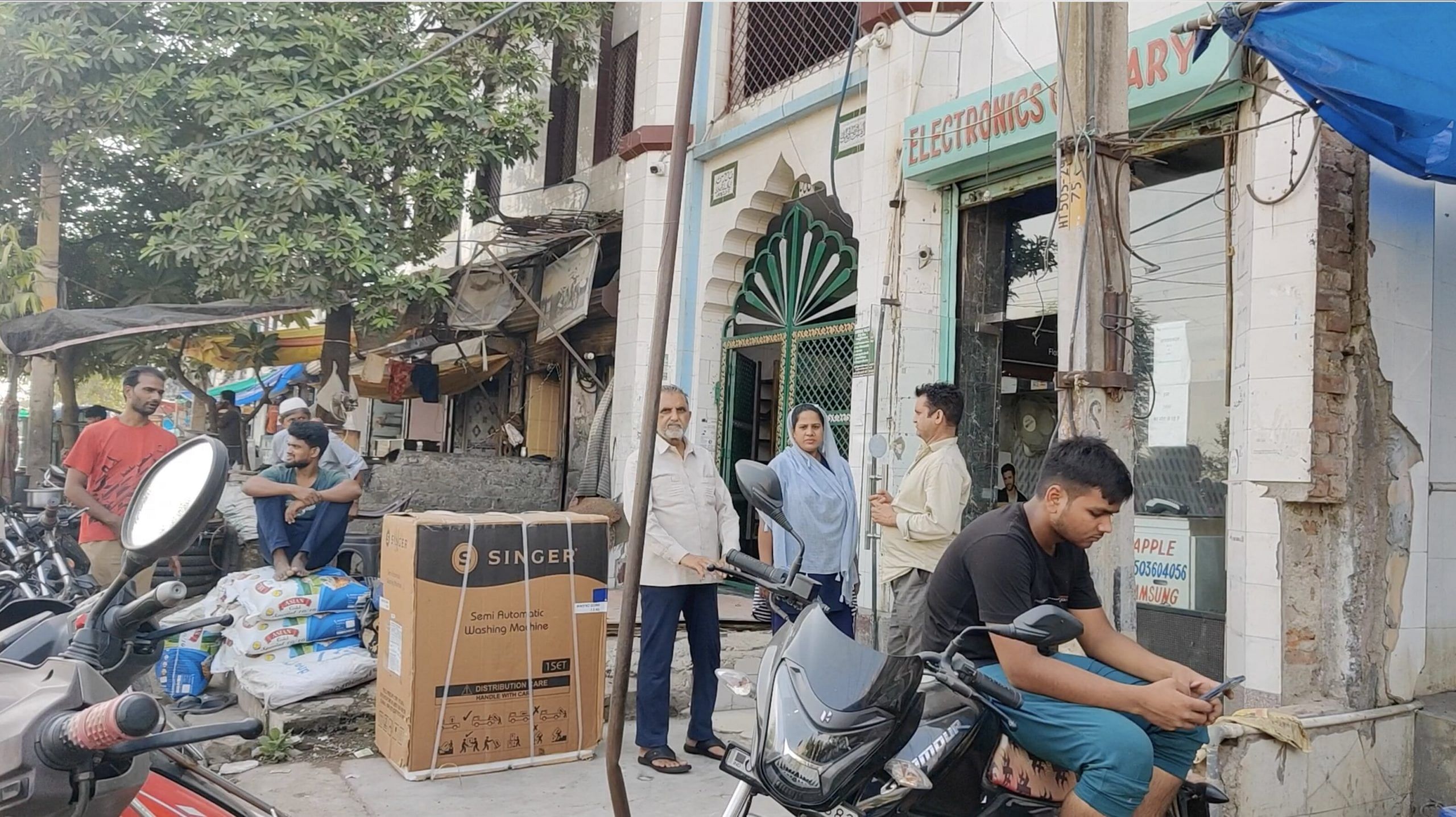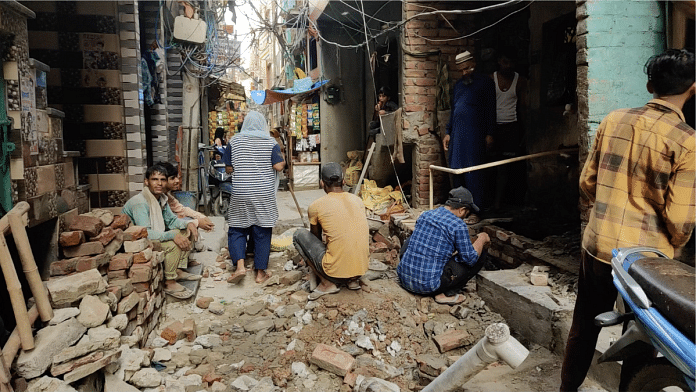New Delhi: It’s 3 pm on a humid August day, and in Block C of north Delhi’s Jahangirpuri, 38-year-old Akbar is busy attending to customers in his small kirane ka dukaan (grocery shop). A cooler stands beside him to help beat the heat.
Pasted just inside his shop is a certificate from the Municipal Corporation of Delhi (MCD) allowing him to conduct his business. It’s there to ensure there’s no repeat of last year, when his shop, along with many others, was torn down by civic authorities following communal violence in the area, he told ThePrint.
On 17 April last year, a procession on Hanuman Jayanti had sparked an altercation between Hindus and Muslims, ending in stone pelting and violence. Three days later, bulldozers rolled in to “remove illegal encroachments” in the area, ordered there by the now-defunct New Delhi Municipal Corporation. By the time authorities stopped the demolition on the back of a Supreme Court order, several structures — including Akbar’s — had already been flattened.
But life has moved on since — Akbar is among the 20 people who have now set up shop again. An MCD official has now told him his shop can’t be touched, he said, pointing to his certificate.
“I took a loan of Rs 3 lakh from the bank to rebuild my shop. This shop is my livelihood and everything depends on it. I’m illiterate, I can’t do any other work. What help will the government give us?” he asked while speaking to ThePrint.

Akbar isn’t the only one. In the year since the incident, residents of Jahangirpuri have picked up the scattered pieces of their lives and moved on, slowly rebuilding their homes and shops. But the incident has left a permanent mark — behind walls of newly-rebuilt shops and houses lurks a fear of a repeat of the past.
Compounding this is the stigma that has itself attached to the area — which mostly houses informal workers either engaged in kabaadi work (scrap dealers) or small-time vending — since the violence.
“This area is being criminalised because some people are trying to create a narrative that these people occupy land (illegally) and are engaged in criminal activities,” Kawalpreet Kaur, an advocate for the Human Rights Law Network in Delhi, told ThePrint. In May last year, the Supreme Court agreed to hear a petition seeking the dismissal of the NDMC’s notification against the demolition.
Kawalpreet is representing Jahangirpuri residents in the proceedings. “These people are trying to ruin the future of these poor vendors,” she told ThePrint, adding that due process wasn’t followed during the demolition.
ThePrint reached Amit Kumar, MCD’s director for press and information, for a response by calls and email. This report will be updated if and when a response is received.
Also Read: Nuh violence got India’s attention, but Mewat wasn’t always communal
‘Criminalisation’ of Jahangirpuri
North Delhi’s Jahangirpuri is a resettlement colony — an area where people who face eviction are eventually settled by the government.
Block C, where most of the demolition happened, is home to mostly Bengali-speaking Muslims from West Bengal, Assam, Bihar, and areas near the Bangladesh border.
When the bulldozers came around 11 am, Akbar didn’t step outside his house for the fear that he might be falsely implicated in the violence case, he told ThePrint.
He suffered a total loss of Rs 4-5 lakh, he told ThePrint. A new fridge was among the possessions he lost. “When they left our area with scattered debris, I was thinking of killing myself, because I was constantly thinking about how I will rebuild everything again,” he said.
Close to Jahangirpuri’s Jama Masjid, Sajid Saifi continues to sell television sets and refrigerators from his still partly-damaged shop. Although he wasn’t as unlucky as some others in the area, business has taken a hit — where he used to earn Rs 1 to 2 lakh a year, he makes only Rs 50,000. This is because most of his customers have stopped coming, he told ThePrint.
“Earlier we used to have customers from other areas of Delhi,” he said. “But now many people don’t come to this area anymore because they’re afraid — they say we’re rioters.”

The walls of his shop are partly broken — a grim reminder of the demolition. But there’s not much he can do about it. “When we attempt to construct it again, the police arrive and stop us saying that we cannot do it until the case has been heard in court,” he said, referring to the Supreme Court proceedings.
In a squalid alley of Block C, 35-year-old Haseena Bibi is chatting with her neighbours. Amid a babble of excited Bengali, children’s laughter rings through the air.
Haseena’s food thela (vending kiosk) was among those that were razed. It has cost her Rs 5 lakh to get a new one. “Outsiders had committed the violence in this area. But people living here have to suffer its consequences,” she told ThePrint. “People haven’t recovered yet. There’s fear that it might be repeated.”
The stigma around the area has made work hard to come by. “When we went to find work outside after our shops were demolished, they (people) chased us away calling us rioters,” Haseena told ThePrint.
The tremors of the violence and the subsequent demolition can be felt in other areas of their lives too. Haseena talks about how her 10-year-old son and other children from Block C were called rioters at a local school until the principal made them stop.
Soon after the violence, the Arvind Kejriwal-led AAP — Delhi’s ruling party — claimed that the BJP had orchestrated the communal violence and the demolition “through the illegal Bangladeshis and Rohingyas”.
Such remarks, according to Haseena, make their situation worse. “Our family belongs to Kolkata. We have all the documents to prove it. Politicians come to seek votes from us and we vote for them. While asking for votes they don’t remember that we are Bangladeshis,” Haseena said. “We’re being used. And we feel very embarrassed that we were not even deemed deserving of a notice of the demolition.”
Also Read: Nuh violence has 3 takeaways for Hindus & Muslims. There’s hope amid the chaos too
‘Right to livelihood’
The MCD — the body that subsumed three of Delhi’s municipal corporations, including NDMC — has cited sections 321 and 322 of the Delhi Municipal Corporation Act of 1957 (DMC Act) to justify its notice-less demolition in the Supreme Court.
Section 321 (prohibition of deposit, etc., of things in streets) reads: “(1) No person shall, except with the permission of the Commissioner and on payment of such fee as he in each case thinks fit, place or deposit upon any street, or upon any open channel, drain or well in any street or upon any public place any stall, chair, bench, box, ladder, bale or other thing whatsoever so as to form an obstruction thereto or encroachment thereon.”
Section 322 — power to remove anything deposited or exposed for sale in contravention of this Act — reads: “The Commissioner may, without notice, cause to be removed (a) any stall, chair, bench, box, ladder, bale or other thing whatsoever, placed, deposited, projected, attached or suspended in, upon from or to any place in contravention of this Act; (b) any article whatsoever hawked or exposed for sale on any public street or in other public place in contravention of this Act and vehicle, package, box or any other thing in or on which such article is placed.”
But according to Kawalpreet, laws such as the Delhi Urban Shelter Improvement Board Act of 2010, the JJ (short for jhuggi jhopri, or shanties) Rehabilitation and Relocation Policy of 2015, and the Delhi High Court’s 2010 ruling the Sudama Singh & Others vs Government Of Delhi & Anr. make advance notices mandatory.
The DMC Act itself has parts on serving notices (sections 441 & 444) and limits on the commissioner’s power to dispose of things removed during demolition (section 326), she said.
“Civic authorities cannot destroy, damage, or bulldoze such things,” she said.
According to Kawalpreet, the law is very clear on the subject — vendors are given certificates to conduct their business at allocated locations and in case of any alleged illegality in this, they must first be served notice.
“Everyone in this country has the right to livelihood. They (residents of Jahangirpuri) are not engaging in any form of encroachment, they are merely vending. If anyone has to be removed, it’s not the job of the police. The MCD has to serve them a notice saying they’re not in their allocated area,” the lawyer told ThePrint.
The MCD, she said, should make it known if there are specifically identified areas where vendors can and cannot sell their wares. “Has the MCD demarcated vending spaces in Jahangirpuri? If that area (where the demolition happened) is one such area, they should make it known,” she said.
ThePrint has asked the MCD’s press and information director about Kawalpreet’s allegations. This report will be updated with his response.
A helping hand
But help has come from some quarters, mostly from non-profits. One such organisation is Aasif Mujtaba’s Miles2Smile, which works to rehabilitate Muslim victims of communal violence. Vendors who lost their businesses in the demolition were given monetary aid, Mujtaba told ThePrint, adding that women were especially given assistance.
“We have provided assistance of Rs 14.5 lakh to 25 families in Jahangirpuri. We have been successful in reviving 90 percent of the shops that were being run by women,” he said.
Mujtaba’s organisation has offered similar assistance in Karauli, where communal violence on 2 April, 2022, left 35 people wounded, and prompted a demolition drive. He is also helping families affected by the demolition that followed the communal clashes in Nuh on 31 August, he told ThePrint.
Bulldozers, he said, are being used to intimidate Muslims, many of whom are among the most marginalised sections of society. “For such people, it’s a multi-layered blow — first the communal violence and bulldozers and then the loans taken to repay them,” he said.
Haseena agrees. “For a poor person, his shop and house is his entire life savings,” she told ThePrint. “The government gives the slogan of Beti Bachao, Beti Padhao. When we don’t have a livelihood, how will I send my daughter to school?”
(Edited by Uttara Ramaswamy)
Also Read: Gurugram-Nuh violence shows how our approach to Hindu Rashtra is wrong. Violence not the way



